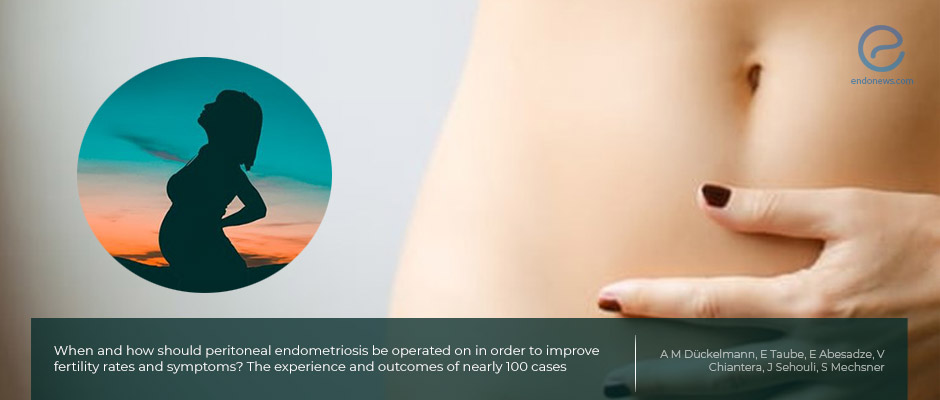The improvement of fertility rate and symptoms of superficial endometriosis following laparoscopic peritoneal stripping
Feb 26, 2021
Timely and comprehensive surgical management and determined fertility treatment would result in a higher chance of conception within two years of surgery
Key Points
Importance:
- The pelvic peritoneum appears to be a key factor for the development and maintenance of endometriosis.
- The literature is short of studies about timing, indications, and treatment procedures concerning peritoneal endometriosis.
- In practice, gynecologic surgeons tend to prefer ablation, however, excision is beneficial as it ensures histopathologic assessment.
Highlights:
- Peritoneal stripping for superficial endometriosis showed improved results particularly on pain relief and fertility rates in endometriosis patients without organ involvement.
What's done here:
- Dückelman et al. from Berlin, Germany set up an analysis on a prospectively maintained database to determine the pain, quality of life, pregnancy, and recurrence rate of "superficial endometriosis patients" who were treated by laparoscopic stripping.
- A total of 94 women with suspected early-stage superficial endometriosis resistant to hormonal medical treatment who received peritonectomy within 5 years were included.
- All peritoneal stripping operations achieved by a single endometriosis surgeon, the follow-up data of 82 patients (87.23%) was available.
- Hormonal treatment discontinued at least 2 months before surgery.
- Confirmation of diagnosis, change in pain, assessment of the quality of life, and pregnancy for patients who wanted a child were the primary outcomes.
Key results:
- A statistically significant improvement was observed in the quality of life of the majority of patients postoperatively.
- Pain relief achieved in more than three-quarters of the study group with one forth becoming symptom-free.
- The fertility rate increased significantly after peritoneal stripping within the timeframe between surgery to follow-up.
- Only two patients had evidence of recurrence on the follow-up.
- No complications were reported in this study period.
Lay Summary
Pain, in the form of diverse entities, including dyspareunia, dysuria, dyschezia, is the main symptom of endometriosis patients. The severity of pain is independent of the extent and the location of the disease, and generally causes a negative impact on the physical, mental, and social wellbeing of the patient. Due to the complex nature of pain and heterogeneity of the underlying disease, the diagnosis, and the differential diagnosis are difficult.
There is no consensus for the treatment of peritoneal endometriosis. It is accepted that the first step in the treatment of patients with suspected endometriosis should be hormonal treatment. Surgery should be considered for hormone-resistant and subfertile patients. Many surgeons perform laparoscopy for the diagnostic purpose, and either leave the residual endometriosis foci behind or ablate the lesions hampering histopathological diagnosis. Literature shows that the surgical management of mild endometriosis is more effective for treating pain, improving the quality of life of the patient, and increasing the fertility rate, compared to diagnostic laparoscopy only. Sharp excision, bipolar diathermy, and ablation with CO2-laser are generally the most preferred surgical techniques for the management of stage 1 or 2 superficial endometriosis.
However, there is a lack of research in the literature concerning the indication and timing for the surgery of peritoneal endometriosis and the surgical method to treat them. Dückelman et al. from the Department of gynecology from Charité-Universitätsmedizin BerlinVirchow Clinic, aimed to analyze the pain, quality of life, and pregnancy and recurrence rate of 94 "superficial endometriosis patients" who had laparoscopic stripping using their prospectively maintained database.
There was a significant improvement in the quality of life of the majority of patients postoperatively. Pain relief was achieved in more than three-quarters of the study group, one fourth of which becoming symptom-free. Furthermore, the fertility rate increased significantly after peritoneal stripping within the timeframe between surgery to follow-up: 62% of patients became pregnant post-surgically, seven had already delivered, six had an ongoing pregnancy, four patients had an abortion, only 3 of which needed assisted reproductive technology. Only two patients had evidence of recurrence on the follow-up, and no complications were reported in the study period. In patients who received further surgery after extensive peritonectomy, all but two had no evidence of endometriosis, neither macroscopically nor histologically at the time of re-operation, however the presence of pain in these patients suggests the up-regulation of pain sensitization and not the disease recurrence.
"We recommend timely and comprehensive surgical management and determined fertility treatment in patients wishing to conceive considering the higher chance of conception within 2 years of surgery and the negative impact of repeated surgery on fertility outcomes" concluded the authors in this interesting paper published recently in "Archives of Gynecology and Obstetrics".
Research Source: https://pubmed.ncbi.nlm.nih.gov/33537880/
peritonectomy peritoneal endometriosis early superficial endometriosis laparoscopy pregnancy infertility pelvic pain endometriosis.

